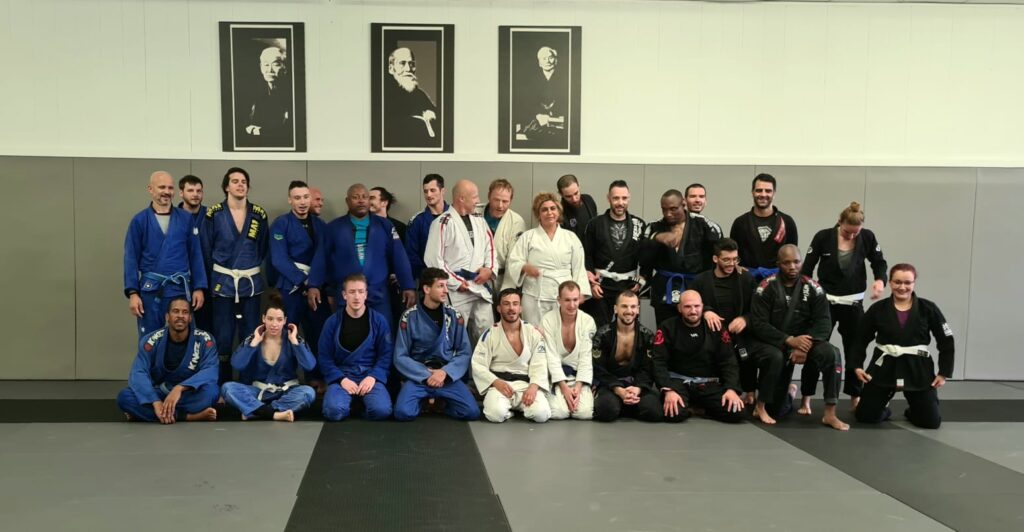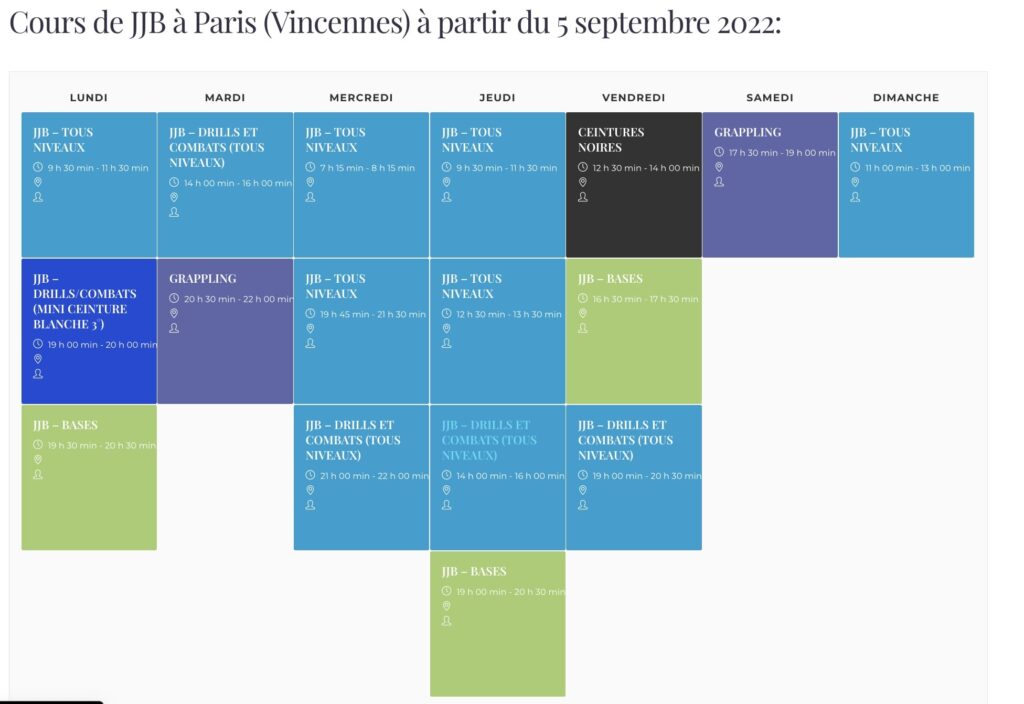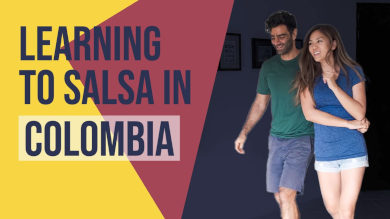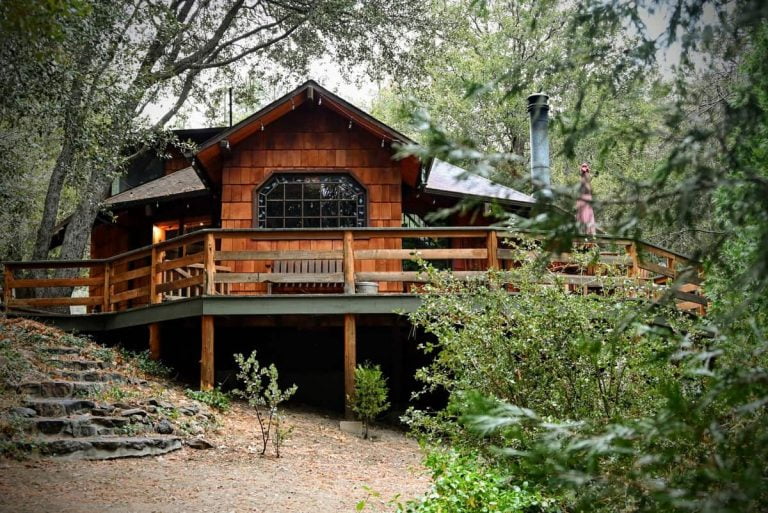Cercle Tissier Review — Training BJJ in Paris, France
For three months in 2022 I trained Brazilian Jiu-Jitsu in Paris, France, in a very established dojo called Cercle Tissier. Among members, we just called it “Le Cercle”.
Before going to Paris (while I was still in Mauritius, training at AJT), I looked around for BJJ (or “JJB” as it’s called in French) schools not just in Paris, but in other parts of France we were considering staying in.
In all of these places I really struggled to find gyms that had much information online about them, that had reviews, or publicly available schedules of all the classes. I emailed a few, realised most would be closed over summer, and so we decided to go to Paris.
So if you’re considering training at Cercle Tissier you’re probably wondering the same things I did, which were:
- What’s the training environment like?
- What’s it like training there in French? Do they speak English?
- What is the “culture” of the club?
- What are the facilities like?
- And what’s the training schedule like?
Here’s the answer to those questions and anything else I can come up with.
You might also like
- My French BJJ vocabulary list
- A beginner’s guide to travelling with Brazilian Jiu Jitsu
Here are my latest posts on combat sports gym reviews from around the world, vocabulary for training in other languages, and other resources. If you’d like to have me visit and see your gym, please contact me — I love visiting new places and making new friends through combat sports.

Contents
Overview — Training at Cercle Tissier
Overall, I loved my time at Cercle Tissier.
Cercle Tissier is often touted to be one of the oldest martial arts dojos in France. Of course, France isn’t Japan or China, so martial arts there are relatively new — but still, they’ve been there for many decades, longer than most readers of this article have been born.
But still, the founders of Cercle Tissier opened the place in the 1970s. That’s a long time!
This is reflected in the fact that Cercle Tissier quite a large space in what has become a little bit of an expensive neighbourhood (Vincennes). They have room for things like a courtyard with a tree in it. Meanwhile, other martial arts clubs around the world are in basement dungeons where rent is cheap and they won’t disturb anyone. Not Cercle Tissier.
Cercle Tissier started as an Aikido club. Many modern martial artists scoff at Aikido as it’s not a real combat sport. But come on, Cercle Tissier was started decades ago when Aikido was just becoming popular in the west.
These days, Aikido still has many practitioners — but they consider it all just good fun, nobody is planning on using it in the “street”. The Aikido classes generally have older folks training there, doing their graceful thing in flowing robes.
Here’s the coolest bit about Cercle Tissier — there are tons of martial arts you can do! Even some I never heard of! And on top of that, there’s dance and some other gymnastics classes, plus things for kids. If you show up at times of day you might see
- People in formal outfits with makeshift weapons clanging against each other
- People in boxing gear thrashing bags
- People in Gis throwing each other around (Judo and even Hapkido)
- People in leotards doing dance moves… oh yeah, they have some dance classes there too
- Legions of kids running around.
And the Cercle many more martial arts, too.
Despite that, Jiu Jitsu is the primary focus of Cercle Tissier. It has the most classes and the most practitioners, and it’s where Cercle Tissier wins most of its trophies. So that’s why I went and what I focused on.
Martial Arts offered at Cercle Tissier
A bit more on the martial arts at Cercle Tissier.
One of the things you notice as soon as you visit the website for Cercle Tissier is the broad range of martial arts offered aside from Jiu Jitsu.
A few of the more common ones are:
- Boxing (“Boxe Anglaise” as it’s called)
- Judo
- Karate
- Aikido
But a few more uncommon ones are
- Capoeira
- Ninjutsu (yes, with weapons, and traditional Japanese garb)
- Hapkido
- Kajukenbo (I don’t even know what this is…)
- Ko-budo (??)
Most of these martial arts aren’t focused on randori / full-contact sparring as Judo and Jiu-Jitsu are. Nobody is going to spar with a guy holding a sword. They focus more on forms and movement — think Tai Chi (but more active). Also, there’s Tai Chi, but it’s under the “Health” section.
Actually, it’s kind of surprising that there’s no Muay Thai or Kickboxing. Maybe there once was — it would depend on teachers being available. It was also surprising there’s no Boxe Française (Savate), a kind of kickboxing-like art I only learned about in France.
It’s important to note two things about all these martial arts.
Firstly, many of them just have 2-3 classes a week. If that martial art is not on a night that suits you, or if they clash with something else you want to do, then tough bikkies.
Secondly, you pay a separate membership for each one. There’s some overlap — like a BJJ membership lets you do grappling/wrestling and even Judo classes — but very there’s little overlap like that.
Aside from martial arts, Cercle Tissier has a pretty active set of programs that are exercise or dance. I didn’t try them but I see many people coming and going from those classes.
The Physical Environment and Facilities

I really liked the environment at Cercle Tissier. To date, it’s the most beautiful dojo I’ve ever seen. (But I haven’t trained in Japan yet!)
There are three main rooms at Cercle Tissier: the main dojo room, an upstairs training room, and a little side room.
The main room is where most big classes are held. It’s huge — it accommodates classes of 30-40 people. In the evenings, you can see up to 15-20 pairs of people rolling at one time.
But that isn’t to say it doesn’t get hectic. No matter how big it is, the evening classes on some nights would be full, and when it came time to rolling, some often had to sit out. Which was fine because everyone needs a break!
I mostly went to the morning classes, which were in the upstairs room. The upstairs room is where a few other classes are held, like those involving bags and mitts (boxing, MMA).

After training in Australia, I came to appreciate air conditioning in a gym. But I was quite surprised to see that no room in Cercle Tissier had air conditioning or even fans! But I spent a summer there training without ever having a day when I was sweltering from the heat inside — France’s summers are mild. But for winter, there’s heating, at least.
You might notice that the floors of the dojos have genuine tatami mats. I really like these. They have a very different feel from rubber or foam padding in many other gyms I’ve found. Sometimes, after taking a fall and landing on the mats, I’d think… wow, these are comfortable. Maybe I’ll lie here for a while…
Showers / Bathrooms / Changerooms
I think this is worth a special mention as it caught me by surprise.
France has a more liberal culture than most places I’ve been to. So in the locker rooms (which are separated men / women), people can be naked and facing each other and chatting with each other. (There is an important exception: any time when children are around.)
I found this unnerving at first, but I got used to it.
Similarly, the shower is a common shower block where everyone is in there naked at the same time, often chatting. Occasionally I’d see people showering in their underwear, so YOU don’t have to be naked, but you should be prepared for other people to be.
Anyone in France reading this is probably laughing at me. Poor sheltered Australian! But I really admire France’s open culture. There should be no fetishization of the human body. You can still respect and admire it without artificially hiding it away. However, it just takes time for a person to adjust to this mentality.
Some other details — take sandals or flip-flops to Cercle Tissier. Any time you’re not on the mats, you’re expected to wear shoes.
Dojo / Gym Culture
I went into Cercle Tissier as a timid blue belt, thinking I got my belt a little early and I was about to get owned. I wasn’t wrong; I was destroyed by many blue belts and even white belts, and at best could just keep some of them honest. I rarely submitted anyone other than relative rookies with less than two years’ experience.
Cercle Tissier is a very competitive gym. This means that
- They regularly announce competitions and focus on developing people for them. The Cercle participates actively in the French league (Championnat de France) and IBJJF rules.
- White belts can often have four to five years of experience; blue belts keep their belts for another few years. I met blue belts that I think were at the level of high-level purple belts at home (it’s a bit hard to judge, as I’m quite junior). Anyway, they were a LOT better than I was.
- Everyone knows how many points things get you, what’s illegal and so on.
Among gyms in Paris, Cercle Tissier is always ranked among the top two. The main thing holding it back is that there are very few women in this gym, so it’s hard to win those competitions! I don’t really know why. Other regional gyms have many more women attending. In my few months at Cercle Tissier I only encountered a few women, mostly white belts, and one female blue belt.
The main competitor on the circuit is MKTeam, another gym I considered. I mostly didn’t go there due to the higher pricing and slightly less convenient location.
Even though Cercle Tissier is quite competitive, not everybody is. There are hobbyists like me who just want to improve and do some exercise without going balls to the wall or subbing every noob. So, it’s easy to find training partners who match your style — I did.
Training style
As I move between gyms, I’ve realised that training style is only partially related to the gyms themselves; they’re more related to the instructor.
The common thing between everyone at Cercle Tissier is that there is (I think) a general curriculum. The goal is to keep things varied but thematically aligned along a calendar year.
But each instructor has their own curriculum. So, if one coach is doing guard passing in May, another might be doing spider guard.
And the curriculums go slowly. In a few months, I only covered a few positions and movements. If I wanted to learn anything myself, I had to go look it up myself, either using something like Grappler’s Guide or Cercle Tissier’s own online resource.
The main coach, Thibaut Olivier, coached with a perspective of “techniques”. A lot of coaches follow this style. He’ll generally in one class coach a technique and show three to four variations. Everyone practises these. Then we just roll. A few other coaches, like Aziz, followed this same style.
My main coach, Fred, coached with quite an unusual style of “positions” (“formes de corps” as he called them). This is a bit of a different approach which I’ll explain.
For example, many coaches will say “Today we’ll do a few sweeps from X-guard”. Then you’ll go through them: one, two, three, and practise them one at a time with a willing partner.
Fred would rather say “This is X-guard. You get in position here. Your goal is to destabilize your opponent in any one of these directions, after which you can do plenty of things.”
Fred would then show us how to really get in position well and influence the movement of the opponent, focusing on their centre of gravity and on really controlling where they go. The next steps — the actual sweeps — eventually came naturally.
Interestingly, Fred almost never showed us actual submissions — unless we asked. When I rolled with him, he never submitted me once. Sure, he got my joints or neck in occasional positions where it was obvious that he could have submitted me, but he never interrupted a roll and reset at that point, because that would interrupt my learning. This is what made him a great coach rather than just a high-level sparring partner.
When we did ask Fred to teach us submissions, the rapidity with which he got into a position made us feel like it would be absurdly easy for him to sub us within 30 seconds if he wanted to! Of course, that’s what I’d expect of a black belt with over a decade of experience against poor little me.
I learned a LOT with Fred. As soon as I got back to my home gym, people noticed that my movement had become a lot more fluid and I was much more comfortable inverted. But on the flipside, I rarely submitted people — still a weakness for me.
The only thing I found lacking in Cercle Tissier is “positional sparring”. This is something I’ve done at a few gyms. You start in a position and each party tries to pass, sweep, or submit. We did it a few times on request, but it’s not a thing I did commonly with the coaches. This of course may change over time.
Oh, and another thing — there is almost no “No Gi” at Cercle Tissier. They have very limited Grappling classes, just twice a week.
Languages used at Le Cercle
If you’re worried about what language to use when training at Cercle Tissier, I’d say you’ll be fine with English for the most part.
The only thing you’ll struggle with is understanding the instruction. I mean, of course you can watch and figure it out visually, particularly if you’re experienced at travelling with Jiu Jitsu.
But there are many times in instruction that a teacher will say something like “Don’t do it like this” or “You’re doing it like this, whereas you should do this.” In situations like that, it’s confusing if you don’t know the words used.
There’s also nuance in detail, like where to push, where to feel your weight. And lots of terms used.
Check out my language guide to training BJJ in French — a full glossary of most terms used.
The coaches mostly speak good English (not all do). France is an educated country. Even though not everyone speaks English “fluently”, generally everyone I’ve met can speak it functionally — they can put together phrases. The very worst case of English I’ve seen would be something like “Not like this… do like this.”
If you do need English instruction, a coach can correct or coach you one-on-one in English. But that’s a function of how much time you have. In big classes (with 30+ students), you would be lucky to get any one-on-one time with a coach.
The members generally do speak English, as most young educated people do, even though most are not natural in it. Some students wanted to speak English with me and that was fine, though I had to teach them English BJJ words, like to say let’s “roll”, not let’s “fight”. Again, even in the very worst case, you’ll be able to communicate with anyone in the Cercle English, sometimes basically and sometimes totally fluently.
Some members of Cercle Tissier also speak other languages, like Spanish, Italian, and German. This is Europe after all.
Cercle Tissier Training Schedule / Timetable
There’s a full schedule on their website. But I found there were a few other classes that weren’t on the schedule.

The most important thing is that you can train at Cercle Tissier every day of the week (including both weekend days!), and on weekdays, multiple times a day.
There are some classes that may not be on the schedule. Fred’s morning classes were a bit chill, as was Fred in general. So he just said “I’ll be here every day of the week at these times” and we showed up for him.
General warning — France really slows down over July and August. In fact, many Jiu Jitsu schools around the country just close, especially over August. Coaches go on vacation, as do support staff, and members do too so there’s little point keeping them open.
Aside from that, many other things nearby may close over summer. One time, I couldn’t get a kebab from my favourite shop after my class. Fail!
Even though Cercle Tissier remained open over July and August, the calendar got lighter. My coach kept most of his classes and was only away for one week. Other classes closed down — most of the non-BJJ martial arts had no classes over July and August.
If you’re not sure how the calendar will change, check out the calendar on Cercle Tissier’s website, and look at how it was like last summer. It’s likely to be similar. You can also email them.
Cercle Tissier doesn’t use a booking app. It’s just whoever shows up. Occasionally I was the only one in the class — it only happened once out of around 60 classes, and it was a mid-morning class. It’ll never happen in the evening or on weekends.
Resources Offered
Unlike many gyms I’ve been to, there’s not a lot of “stuff” you can buy at Cercle Tissier. I did buy a gi, but they only came in stock around two months after I joined — they make them sporadically, around competition time. The gym doesn’t sell rash guards or other stuff.
One cool / unique thing offered by Cercle Tissier is their website of videos. You can find them at cercletissierjjb.com.
There are lots of troves of technique videos online, but what I liked about this was that these are made by THIS gym and they’re in French. By watching them, I picked up a lot of French BJJ lingo (see my guide) and also got an overview of what this school teaches.
For example, Cercle Tissier is quite heavy on a few techniques like leg drag, and quite light on things like ankle locks and knee bars. When I found myself getting leg dragged to hell, I went online and found some explanations as to why.
But as soon as I left, I started getting leg locked again!
Communication in groups
Cercle Tissier uses big WhatsApp groups for announcements. Some coaches just SMS their students too.
There are a few groups
- The general banter group with 150+ members. I posted in this a few times and got a few responses that were jokingly sexual in nature. E.g. I said I had lost my back massager, and someone (an old-school member, too, not some kid) posted a picture of a vibrator and said “Is this it?”. The group is like this. It’s vaguely funny, but kind of annoying too… anyway I generally didn’t find the group useful as a new member.
- An “announcements” group where only coaches can post. I for some reason never got added to this group, I think they kept forgetting (I asked a couple of times).
- A women’s only group that I heard of from Hind, one of the female members.
My coach Fred just got my number and he said he would send an SMS to everyone if he couldn’t show up for some reason. In the three months I was there, he never sent one SMS.
Competitors to Cercle Tissier
There are two main gyms I considered as alternatives to Cercle Tissier.
- MKTeam — seems like a really cool club, and they were super responsive with email. The only reason I didn’t go was that they cost double and they were further away. The environment also didn’t look as pretty.
- RNK Paris — a mixed BJJ / Grappling gym with a few locations around Paris. Looks better for no-gi, but it was way more expensive.
- Gracie Barra — I didn’t really consider it but I know others who’ve trained there. I know Gracie has an excellent curriculum, and if you’re in the circle already it’s cool, but I didn’t want to buy their gi and I don’t like bowing to pictures of people. But they do have a couple of well-respected locations in Paris.
I guess the hardest part about training in Paris is that it’s mostly gi, with much less no-gi. Part of the reason for this is the relative absence of MMA in France. It can’t be televised and there are very few gyms, even though France has a few global-level contenders. I’m sure that’ll change over time.
Pricing
I thought the pricing at Cercle Tissier to be very competitive. I paid 80 euros a month and had a schedule with classes every day — even weekends — with multiple time slots. Though not all the classes were the same (see the calendar section above).
I paid a 60-euro insurance fee, which is annual. So on average I paid 100 euros a month. This is much less than I pay for training in many other developed major cities.
Because of the insurance fee, I don’t think a drop-in is possible. You can probably show up to an open mat, but don’t tell anyone you’re not insured!
One thing to note is that Cercle Tissier has different memberships and pricing for different martial arts. So just because you’re paying for BJJ, you can’t automatically do boxing! You can definitely do trial classes in the other martial arts, though, and if the timetable works, you can do more than one.
It’s also cool that you can sign up to the Cercle online and pay with your credit card. But you can’t pay at the counter with a credit card at this stage.
Sum up
I really enjoyed my time at Cercle Tissier. I made a few friends quickly and learned a lot over the three months. I wish I could stay for a full year and really earn my blue belt by French standards.
Not sure when I’ll go back, but one day I will!
After Cercle Tissier, I made a brief stop-over in my family’s home city at SASSOM again, before making my way to Seoul, Korea to train at Cube MMA for three months.






